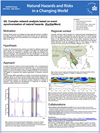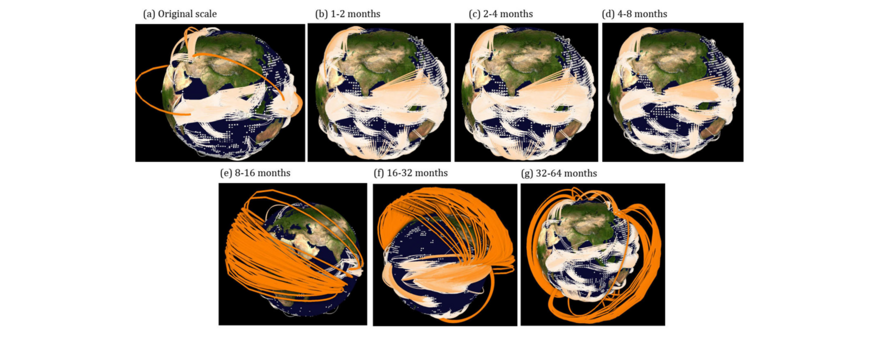PhD-Project Q2 by Ankit Agarwal (PIK/UP): Complex network analysis based on event synchronization of natural hazards
Timescale: Oct. 2015 – Jan. 2019
Supervisors:
Prof. Dr. Jürgen Kurths, Potsdam Institute for Climate Impact Research (PIK)
Prof. Dr. Bruno Merz, Helmholtz Centre Potsdam GFZ German Research Centre For Geosciences
Background
Traditionally, floods are seen as essentially random events, and extreme flood occurrence and magnitude are assumed to correspond to an independent, identically distributed random process. However, unusually large floods in drainage basins of all sizes seem to be related to large-scale atmospheric circulation anomalies. Recent work has shown that 20 major flood events over the last 100 years had nearly identical storm tracks, moisture source and delivery patterns. Such persistent anomalies may in turn reflect modulation by climate phenomena such as the El-Niño Southern-Oscillation (ENSO) and North-Atlantic Oscillation (NAO). For regions where floods are tightly linked to meteorological conditions (e. g., strong influence of ENSO on flooding in Peru) traditional regression-based approaches may be sufficiently reliable. In most other regions new methods are needed to decipher the more subtle linkages between climate and floods (e. g., Western Europe winters being only weakly linked to NAO).
Objectives and Methods
The PhD-project aimed at understanding space-time dynamics of extreme natural events by using complex networks. Complex networks based on event synchronization are a novel approach for studying space-time dynamics of strong natural events. By analysing the concurrent or lagged occurrence of extreme events at different locations, this technique has been successfully applied to new phenomena of the spatial organisation of extreme monsoon rainfall in Asia and South America. In this project, the technique was generalised to include more physical parameters. A special challenge was to combine synchronisation of event-based networks with networks obtained from other climate and flood-influencing variables, such as temperature or catchment wetness, leading to a network of networks. This included the development of appropriate measures of causality to quantify possible interactions between the networks. The methods were adapted for spatio-temporal climate and flood data, with the ultimate goal of better understanding how extreme river floods in Central Europe and in the Mekong River Basin are linked to climate.
Flood times series of up to ten river gauges in Central Europe and in the Mekong River Basin of different magnitude (e.g. peak-over-threshold with on average three events per year) and associated meteorological and catchment variables (sea surface temperature, atmospheric pressure, rainfall, snow cover, soil moisture, etc.) will be derived. From the data a network of networks is constructed where the interactions within each network and, more challenging, between the networks should provide new insights in the underlying mechanisms. Time-dependent analysis techniques for non-stationary data and statistical methods for testing the significance of transient structural properties in this network of networks have been further developed.
Main results
This thesis provides substantial contributions to the research field of hydro-climatology, comprising:
- Demonstration of the importance of multi-scale interactions within climatology and hydro-meteorology.
- Development of two novel methods (multi-scale event synchronization, wavelet multi-scale correlation) for quantifying interactions at different time scales.
- New insights into the characteristics of sea-surface teleconnections and of spatial diversity of Indian rainfall teleconnections.
Publications within NatRiskChange:
AGARWAL, A., BOESSENKOOL, B., FISCHER, M., Hahn, I., Köhn, L., LAUDAN, L., MORAN, T., OZTURK, U., Riemer, A., Rözer, V., SIEG, T., VOGEL, K., WENDI, D., Bronstert, A., Thieken, A.H. (2016): Die Sturzflut in Braunsbach, Mai 2016 - Eine Bestandsaufnahme und Ereignisbeschreibung. Taskforce im Rahmen des DFG-Graduiertenkollegs Natural Hazards and Risks in a Changing World, Universität Potsdam (Publisher), 20 pages, urn:nbn:de:kobv:517-opus4-394881.
AGARWAL, A., Caesar, L., Marwan, N., Maheswaran, R., Merz, B., Kurths, J. (2019): Network-based identification and characterization of teleconnections on different scales. Nature Scientific Reports, 9(1):8808, https://www.nature.com/articles/s41598-019-45423-5.
AGARWAL, A., Marwan, N.,OZTURK, U., Rathinasamy, M. (2019): Unfolding Community Structure in Rainfall Network of Germany Using Complex Network-Based Approach: Climate and Environment, pp 179-193, In: Water Resources and Environmental Engineering II. Springer Verlag, https://doi.org/10.1007/978-981-13-2038-5_17.
AGARWAL, A., Maheswaran, R., Marwan, N., Caesar, L., Kurths, J. (2018): Wavelet-based multiscale similarity measure for complex networks. The European Physical Journal B, 91: 296, https://doi.org/10.1140/epjb/e2018-90460-6
AGARWAL, A., Marwan, N., Maheswaran, R., Merz, B., Kurths, J. (2018): Quantifying the roles of single stations within homogeneous regions using complex network analysis, Journal of Hydrology, https://doi.org/10.1016/j.jhydrol.2018.06.050
AGARWAL, A., Marwan, N., Rathinasamy, M.,OZTURK, U.,Merz, B., Kurths, J. (2018): Optimal Design of Hydrometric Station Networks Based on Complex Network Analysis, Hydrol. Earth Syst. Sci., https://doi.org/10.5194/hess-2018-113, in press.
AGARWAL, A., Marwan, N., Rathinasamy, M., Merz, B., Kurths, J. (2017): Multi-scale event synchronization analysis for unravelling climate processes: A wavelet-based approach, Nonlinear Process. Geophys., 24: 599-611, https://doi.org/10.5194/npg-2017-19.
Bronstert, A., AGARWAL, A., BOESSENKOOL, B., Crisologo, I., FISCHER, M., Heistermann, M., Köhn-Reich, L., López-Tarazón, J.A., MORAN, T., OZTURK, U., Reinhardt-Imjela, C. (2018): Forensic hydro-meteorological analysis of an extreme flash flood: The 2016-05-29 event in Braunsbach, SW Germany, Science of the Total Environment, 630: 977-991. doi.org/10.1016/j.scitotenv.2018.02.241.
Bronstert, A., AGARWAL, A., BOESSENKOOL, B., FISCHER, M., Heistermann, M., Köhn-Reich, L., MORAN T., WENDI, D. (2017): Die Sturzflut von Braunsbach am 29. Mai 2016 – Entstehung, Ablauf und Schäden eines „Jahrhundertereignisses“. Teil 1: Meteorologische und hydrologische Analyse, Hydrologie & Wasserbewirtschaftung, 61(3): 150-162, https://doi.org/10.5675/HyWa_2017,3_1.
Ekhtiari, N., AGARWAL, A., Marwan, N., Donner, R. V. (2019): Disentangling the multi-scale effects of sea-surface temperatures on global precipitation: A coupled networks approach, Chaos, accepted, https://aip.scitation.org/doi/10.1063/1.5095565. This article has been selected as an Editor's pick and released as a featured article.
Kurths, J., AGARWAL, A., Shukla, R., Marwan, N., Rathinasamy, M., Caesar, L., Krishnan, R., and Merz, B. (2019): Unravelling the spatial diversity of Indian precipitation teleconnections via a non-linear multi-scale approach, Nonlin. Processes Geophys., 26: 251–266, doi.org/10.5194/npg-26-251-2019.
Meng, J., Fan, J., Ludescher, J., AGARWAL, A., Chen, X., Bunde, A., Kurths, J., and Schellnhuber, H.J. (2019): Complexity based approach for El Niño magnitude forecasting before the spring predictability barrier (PNAS). https://www.pnas.org/content/early/2019/12/23/1917007117.
OZTURK U.,Marwan N., Korup O., Saito H., AGARWAL A., Grossman M. J., Zaiki M., Kurths J. (2018a): Complex networks for tracking extreme rainfall during typhoons, Chaos, 28(7): 075301, https://doi.org/10.1063/1.5004480.
OZTURK U., WENDI D., Crisologo I., Riemer A., AGARWAL A., VOGEL K., López-Tarazón A. J., Korup O. (2018c): Rare flash floods and debris flows in southern Germany, Science of the Total Environment, 626: 941-952, https://doi.org/10.1016/j.scitotenv.2018.01.172.
Rathinasamy, M., Agarwal, A., Sivakumar, B., Marwan, N., and Kurths, J.: "Wavelet analysis of precipitation extremes over India and teleconnections to climate indices. Stochastic Environmental Research and Risk Assessment. https://link.springer.com/article/10.1007/s00477-019-01738-3
VOGEL, K., OZTURK, U., Riemer, A., LAUDAN, J., SIEG, T., WENDI, D., AGARWAL, A.,Rözer, V., Korup, O., Thieken, A.H. (2017a): Die Sturzflut von Braunsbach am 29. Mai 2016 - Entstehung, Ablauf und Schäden eines “Jahrhundertereignisses”. Teil 2: Geomorphologische Prozesse und Schadensanalyse, Hydrologie & Wasserbewirtschaftung, 61(3): 163-175, https://doi.org/10.5675/HyWa_2017,3_2.
Thesis to download:
Unraveling spatio-temporal climatic patterns via multi-scale complex networks


